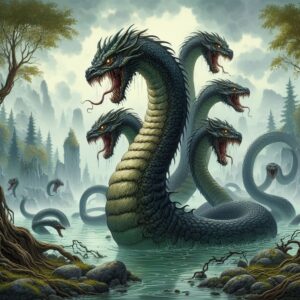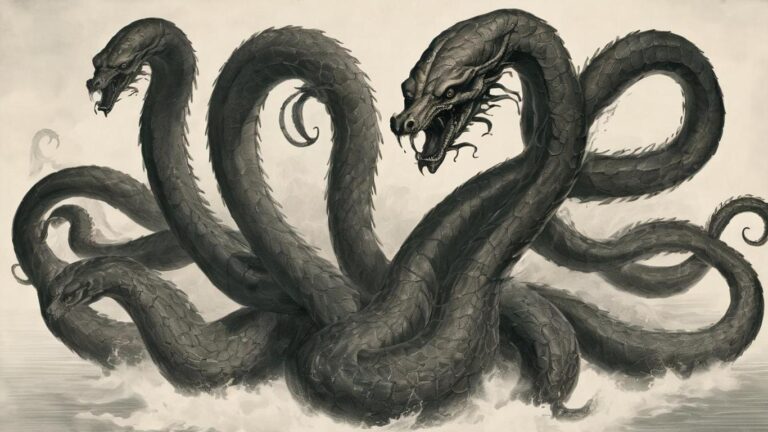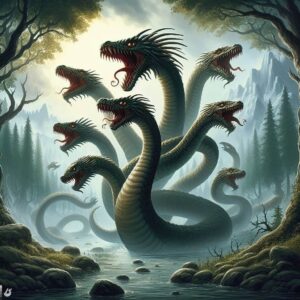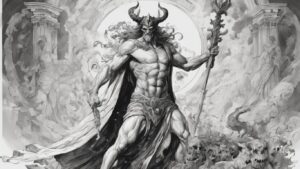Table of Contents
In Greek mythology, the Hydra, a monstrous serpent-like creature with multiple heads and a poisonous breath, originates from the underworld and primordial beings. Most myths attribute its parentage to Typhon and Echidna, monstrous entities symbolizing chaos and untamed forces.
Considered the monstrous parents of various legendary creatures in Greek mythology were Typhon, a giant with a hundred dragon heads, and Echidna, a serpent-like creature with a woman’s torso. The Hydra’s lair in the marshes of Lerna served as the backdrop for its terrorizing attacks on livestock and locals.
The Hydra’s regenerative ability, where two heads would grow for every one severed, heightened its challenge as a formidable foe. This regenerative power significantly increased the difficulty of Heracles‘ task when he was assigned to slay the Hydra as part of his Twelve Labors.
Appearance

The Hydra commonly exhibits serpent or dragon-like features, with each head possessing distinct personalities and, in some accounts, emitting deadly toxins. Descriptions often highlight tough or impenetrable skin. Some versions consider the central head immortal, intensifying the challenge of defeating the creature. The Hydra’s lair in the marshes of Lerna intensifies the hero’s difficulty, depicted as a dark and treacherous place. The creature’s regenerative ability is a central aspect of its mythology, symbolizing the seemingly insurmountable challenges that heroes must overcome. Various artistic interpretations may depict the Hydra with additional embellishments, capturing the imagination of different cultures and time periods.
Powers:
The Hydra typically exhibits multiple heads, often nine, making it a unique and challenging opponent in classical accounts. It possesses the remarkable ability to regenerate heads; when one is severed, two or more may grow in its place, adding complexity to defeating the creature. Descriptions highlight the Hydra’s blood and breath as poisonous and deadly, enhancing its danger and presenting a unique hazard in mythology. Some versions of the myth attribute an immortal central head to the Hydra, further increasing its formidable nature.
Weakness:
Decapitation: The Hydra’s unique weakness lies in decapitation. While it can regenerate heads, if all heads are severed and the central immortal head is destroyed, the Hydra can be defeated.
The Twelve Labors of Heracles included the slaying of the Hydra, and it was through strategic thinking and the help of his nephew Iolaus that Heracles succeeded in overcoming the creature by cauterizing the necks of the severed heads to prevent regeneration. The story emphasizes the importance of intelligence and resourcefulness in overcoming seemingly invincible challenges.
FAQ
How many heads is the Hydra typically depicted with?
The Hydra is often depicted with nine heads in classical accounts.
What is the unique challenge posed by the Hydra's regenerative ability?
If one head is severed, two or more heads may grow in its place.
What is a notable characteristic of the Hydra's blood and breath?
The blood and breath of the Hydra are often described as poisonous and deadly.
What hazard does the Hydra's venomous aspect present in mythology?
The Hydra's venomous aspect provides a unique weapon and hazard.
Where is the Hydra's lair in Greek mythology?
The Hydra's lair is typically portrayed in the marshes of Lerna.
Who assigned the task of slaying the Hydra to Heracles?
King Eurystheus assigned the task to Heracles as one of his Twelve Labors.
What role does the Hydra play in the night sky according to mythology?
The Hydra is placed in the night sky as the constellation Hydra.





